THE THEATRE ORGAN
PART THREE
THE ORGANS & ORGANISTS
of
THE GRANADA THEATRE CIRCUIT
-oOo-
PAGE ONE
INTRODUCTION
-oOo-
Most theatres of the Granada Theatre Circuit, like a number of cinemas of the other circuits, were installed with a theatre organ. The Granada Theatre Shrewsbury was the only purpose-built theatre of the circuit that did not have a theatre organ installed at its opening. Although the organ of choice of the Circuit was the Mighty Wurlitzer, the first purpose built theatres of the Circuit, the Granadas at Dover and Walthamstow, had Christie Theatre Organs installed, as well as that of the Granada Theatre Maidstone.
-oOo-
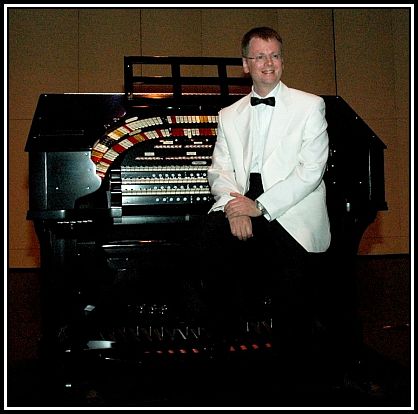 Simon Glenhill at the 3 manual-25 rank Wurlitzer Organ at the Washington Center for the Performing Arts, Olympia, Washington
Simon Glenhill at the 3 manual-25 rank Wurlitzer Organ at the Washington Center for the Performing Arts, Olympia, Washington
-oOo-
During the heyday of cinema-going, going to the pictures was an important recreational pursuit. In those days, in addition to the screening of the latest releases, patrons were treated to a variety of supporting features between the screenings of a double feature. This included a number of theatrical acts appearing live on stage together with a Newsreel detailing the important and often less-important events of the day and perhaps one or two short films either in the form of a cartoon or else a travelogue. Sandwiched between these additions, but of major significance, would be a musical interlude when the house theatre organ was played. The theatre organ interlude was immensely popular and many of the organists went on to become household names.
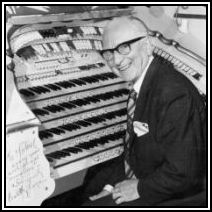 Click here for a musical interlude by Bobby Pagan
Click here for a musical interlude by Bobby Pagan
-oOo-
It was always an exciting moment when suddenly the houselights began to slowly dim until the auditorium was left in almost total darkness. In anticipation of what was to follow, a hush would fall over the waiting audience, which was suddenly broken by the seemingly distant sounds of the theatre organ being played in the bowels of the orchestra pit! A spotlight now illuminated the empty space at the centre of the orchestra pit and, as the glorious resonating sounds grew louder, the organ rose up to be bathed in the limelight and take its place before the stage. This magnificent and spectacular theatrical entrance was always greeted by an exuberant explosion of applause from a grateful audience. Just imagining this cannot but cause the hair on the back of one’s neck to stand-up!
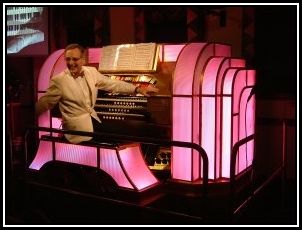 Len Rawle at the Wurlitzer Organ (3/23) at Singing Hills Golf Club in 2004
Len Rawle at the Wurlitzer Organ (3/23) at Singing Hills Golf Club in 2004
This photograph is the copyright of Webbwize and is reproduced here with permission of
the photographer, Alan K. Baker
Click here to hear the organ being played by Michael Wooldridge
-oOo-
The first tune played by the organist would invariably be a lively tune known to the audience which put them in the right mood for the short concert. The pieces played by the organists were generally chosen to display their ability to play tunes of different styles and of varying complexity. Few in the audience were not impressed by the dexterity of the virtuoso!
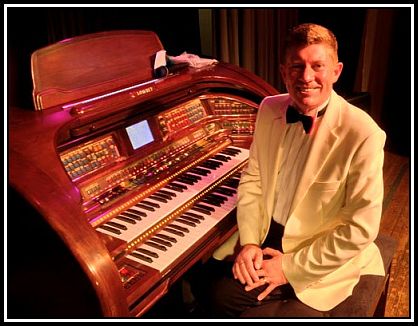 Click here to hear and see an example of this dexterity by the virtuoso, Robert Wolfe
Click here to hear and see an example of this dexterity by the virtuoso, Robert Wolfe
-oOo-
Many of the resident organists of the various circuits were not only virtuosos, but also showmen and knew how to entertain and give the audience a good show. Many dressed in white suits, often with some sparkling additions in order to catch the light so as to add the spectacle. Others were more sedate, but this did not detract from their ability to entertain and please the audience.
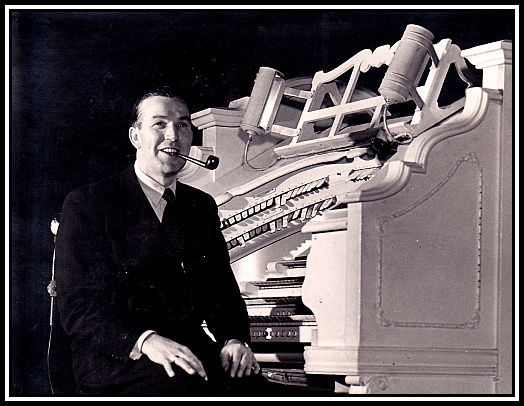 H. Robinson Cleaver was not only a great organist, but also a great showman
H. Robinson Cleaver was not only a great organist, but also a great showman
H. Robinson Cleaver playing a selection of tunes made famous by Miss Grace Moore
-oOo-
The organists were accomplished musicians and many appeared on the radio and also made recordings for sale. During the early days of BBC Radio, up until the 1960s, weekly theatre organ concerts were part of the line-up of the Light Programme. Such concerts were often presented from a cinema with many of the Granada Theatre Circuit being chosen as the venue, which allowed a number of the organists to become household names.
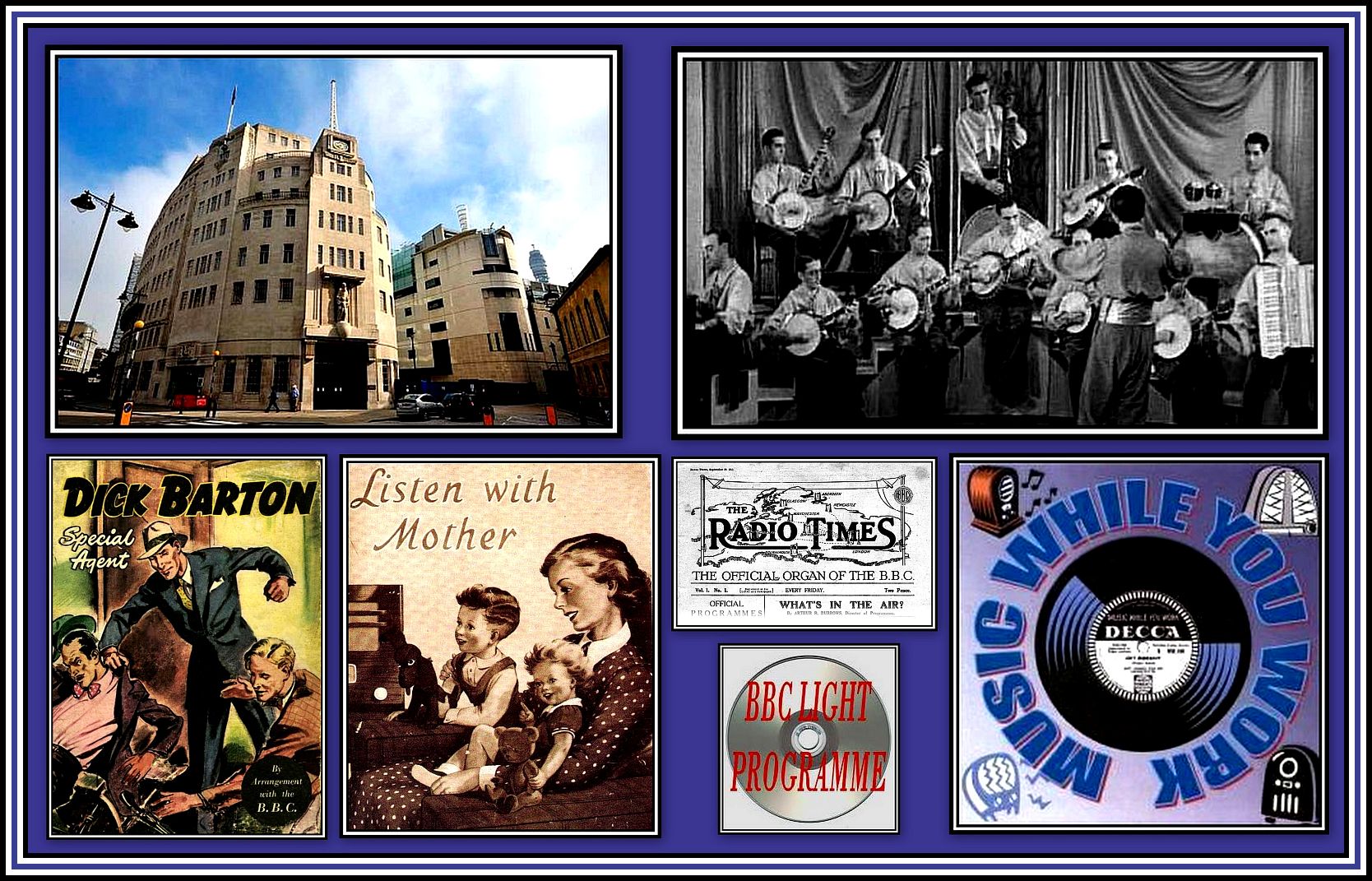 Top Left: BBC Broadcasting House; Top Right: Troise & His Banjoliers
Top Left: BBC Broadcasting House; Top Right: Troise & His Banjoliers
Bottom Left: Dick Barton, Special Agent;
Bottom Middle Left: Listen With Mother;
Bottom Right: Music While You Work
Click here to hear the theme of Dick Barton, Special Agent
Click here to hear the start of Listen With Mother
Click here to hear the theme of Music While You Work
Click here to hear Troise & His Banjoliers
-oOo-
Perhaps the best known organist to the general public was Reginald Dixon who was the resident organist at The Tower Ballroom Blackpool between March 1930 and March 1970 and who was known as Mr. Blackpool by the public. He made more recordings than any other organist, which sold well and placed him on a par with the top singers of his day. During his fifty-year career, Reginald Dixon was always in demand. In the winter of 1935-36, he made a tour of the Granada Theatre Circuit, which proved most successful. On the 18th February, 1936 Mr. Dixon made a broadcast from the Granada Theatre Tooting. During the Second World War, he served in the Royal Air Force and while stationed near Slough, he made several recordings on the Wurlitzer installed at the Granada Theatre Slough. He also made a number of recordings at other Granada Theatre Organs including those of Welling, Tooting, Kingston-Upon-Thames and Clapham Junction. His radio concerts were immensely popular and his last concert from The Tower Ballroom Blackpool in 1970 was broadcasted by the BBC. Although officially retired, he continued to broadcast and tour and was always well-received by an appreciative audience.
Click here to read a tribute to Reginald Dixon and to hear him play a series of Quicksteps
Click here to hear Reginald Dixon at the Wurlitzer Organ of the Granada Theatre Slough
-oOo-
Sidney Bernstein was greatly influenced by the Movie Palaces that he saw during his earliest trips to the U.S. Although the Palaces impressed him, he was appalled by the quality of films shown in them, which made him realise that it was THE THEATRE that attracted people and not the films being shown.
-oOo-
I had to smile when I read this of Mr. Bernstein. I had suffered often during my early childhood from the fact that my mother would always chose the Excelsior Kinema whenever we went to the cinema. She paid no attention to What’s On, but gained immense pleasure from just going to this small cinema. She had a favourite seat in the auditorium. It was close to the Exit and at the end of an aisle. She was never happy when a patron had dared to take this seat and she would be forced to sit nearby where she kept one eye on the annoying patron while wishing and willing them to leave. Should they oblige, she was up and out of her seat at the speed of light and over to claim her rightful place.
It took me many years to learn to love that cinema and today, naturally I do. Sadly it has been demolished like so many other wonderful Palaces. I now smile to myself whenever I see, as I call them, an old Excelsior Film being shown on television. When I do, I generally stop and watch it and this is where I smile even more, I always seem to enjoy them very much now. While smiling, I remember the days when I sat between my parents praying for such a film to be over!
-oOo-
During a visit to the U.S. in 1927, Mr. Bernstein visited the Roxy Theatre in New York. Here, besides being impressed with the theatre, he was also impressed by the orchestra that was performing in the Movie Palace and also with the stage shows. As impressive as these events were, what perhaps impressed him the most was the playing of the theatre organ. And who would not be impressed by the Kimball theatre organ? This magnificent instrument was installed with three consoles and each was played by an accomplished organist dressed in a green velvet smoking jacket! The sight and sound of this spectacle must have been remarkable, and Mr. Bernstein, being a showman himself, would most certainly have appreciated this aspect of the event.
Click here to hear a Kimball Theatre Organ being played
——oooOOOooo——
ACKNOWLEDGEMENTS
I would like to thank Mr. Wayne Ivany for providing many of the photographs that appear in this piece and also for providing a number of the facts that form the basis of it.
I would like to thank Webbwize and Mr. Alan K. Baker for allowing their photograph to be reproduced here.
——oooOOOooo——
——oooOOOooo——
Click here to return to THE THEATRE ORGANS & ORGANISTS OF THE GRANADA THEATRE CIRCUIT – HOME PAGE
——oooOOOooo——
Click here to GO to PART FOUR:
THE ELECTRIC-PNEUMATIC SYSTEM OF THE THEATRE ORGAN
——oooOOOooo——
Click here to return to the GLOSSARY
——oooOOOooo——
Click here to return to THE THEATRE ORGAN Home Page
——oooOOOooo——
Click here to return to the TABLE OF CONTENTS
——oooOOOooo——

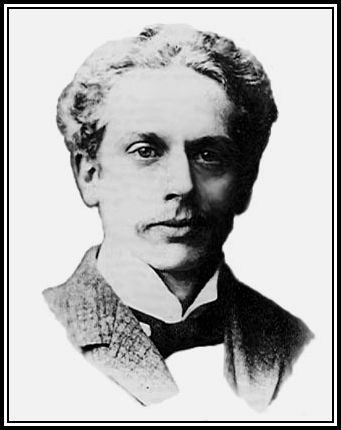
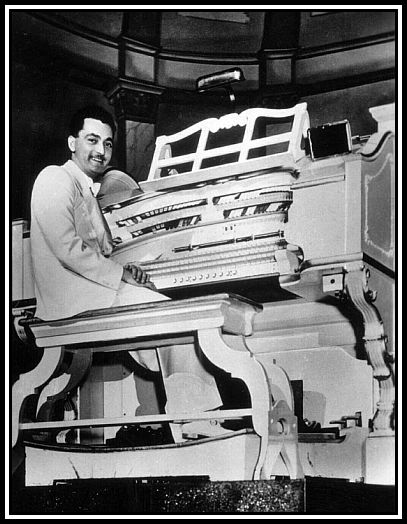
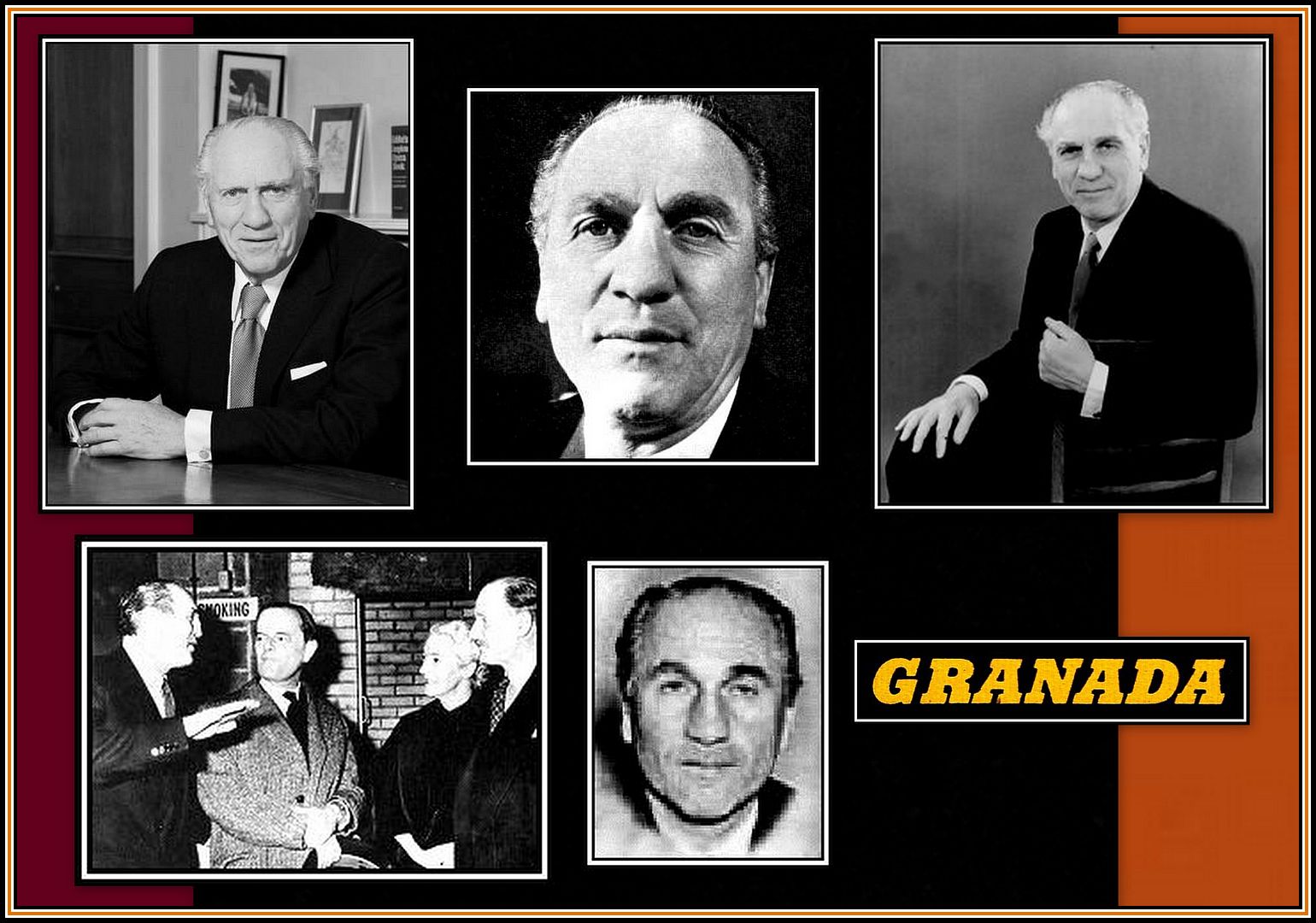
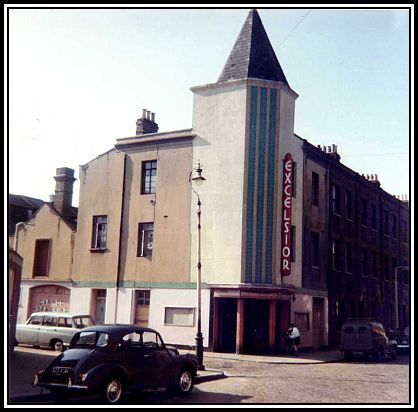
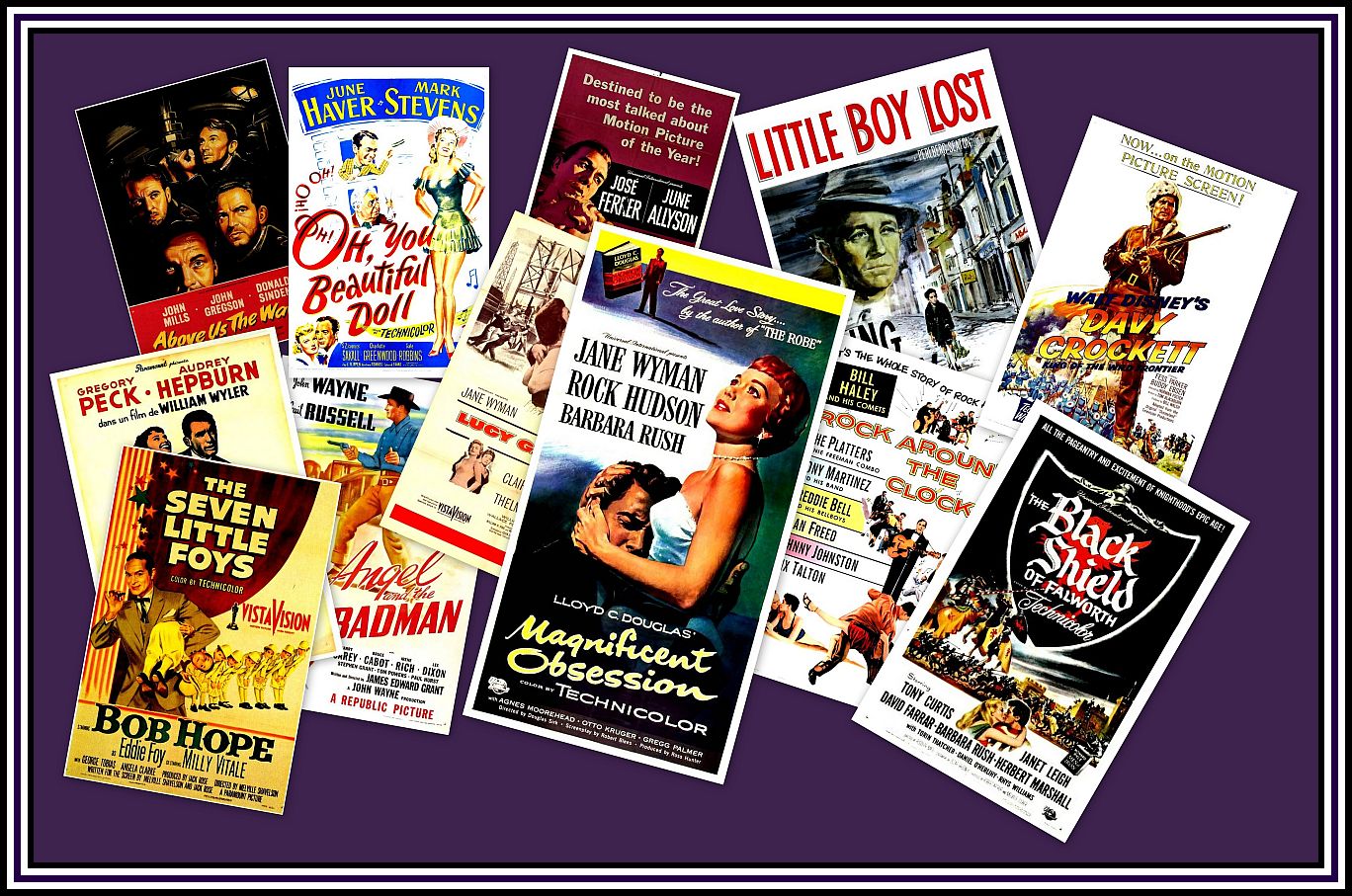
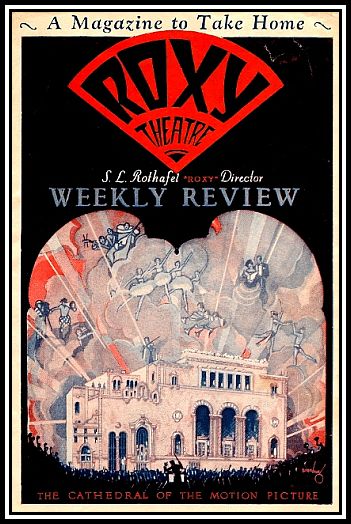
Your website is outstanding, thank you for all your hard work. The infomation and pictures are a great mine of infomation. Folk on facebook including myself have used your site as a point of reference several times in the last few week. Well done Best wishes
Thank you very much for your kind comments. It is much appreciated.
Hello Charles
Was using your excellent ages for research (again!) and I came across the link to the Vic Hammett recording. You indicate ‘to hear him play theatre organ’ when in actual descriptive terms this is not correct. This links to Vic playing the Baldwin ELECTRONIC organ, although it sometimes was refereed to as an Electronic theatre organ. But a THEATRE organ it ain’t! Kind regards.
Many thanks for pointing this out. Correction to the text has been made. Charles